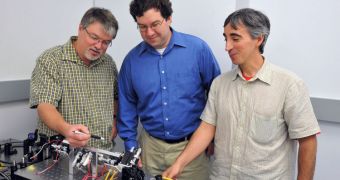Spacecraft and astronauts in science-fiction movies have had access to tractor beam technology for decades, but it's only now that a team of researchers at NASA is beginning to actually research the concept in real-life. The group was recently awarded funds to conduct this investigation.
Simply put, a tractor beam signifies a beam of laser light that can be used to trap and manipulate objects. In SF applications, it is used by one spacecraft to trap another, and expert say that maybe this is what the real-world version of the technology should strive to achieve as well.
For example, the beam may be used to capture particles and dust from the surface of planets, moons and comets, and then deliver it inside an orbiter or rover. In this manner, sample-return missions would become easier to conduct than ever.
The team that will conduct the research is based at the NASA Goddard Space Flight Center (GSFC), in Greenbelt, Maryland, and is made up of principal investigator Paul Stysley and team members Barry Cole and Demetrios Poulios. Together, they received $100,000 for the research effort.
The money was awarded by the NASA Office of the Chief Technologist (OCT). The grant calls for the study of three separate experimental methods for corralling particles, and then transporting them to an instrument using nothing more than laser light.
What the new technology should resemble, physicists believe, is a vacuum cleaner using the power of a vacuum to pick up and then transport dust particles all the way to a storing chamber. The difference would be that a tractor beam would deliver its cargo inside a scientific instrument.
“Though a mainstay in science fiction, and Star Trek in particular, laser-based trapping isn't fanciful or beyond current technological know-how. The original thought was that we could use tractor beams for cleaning up orbital debris,” Stysley explains.
“But to pull something that huge would be almost impossible – at least now. That's when it bubbled up that perhaps we could use the same approach for sample collection,” he goes on to explain.
The OCT provided funds for this new research under the newly-reestablished NASA Innovative Advanced Concepts (NIAC) program, which was terminated for some time, but was not brought online again. For NIAC, the OCT usually gets hundreds of proposals, of which it selects about 30.
“Once we select a technique, we will be in position to then formulate a possible system. We're at the starting gate on this. This is a new application that no one has claimed yet,” Coyle explains.

 14 DAY TRIAL //
14 DAY TRIAL //